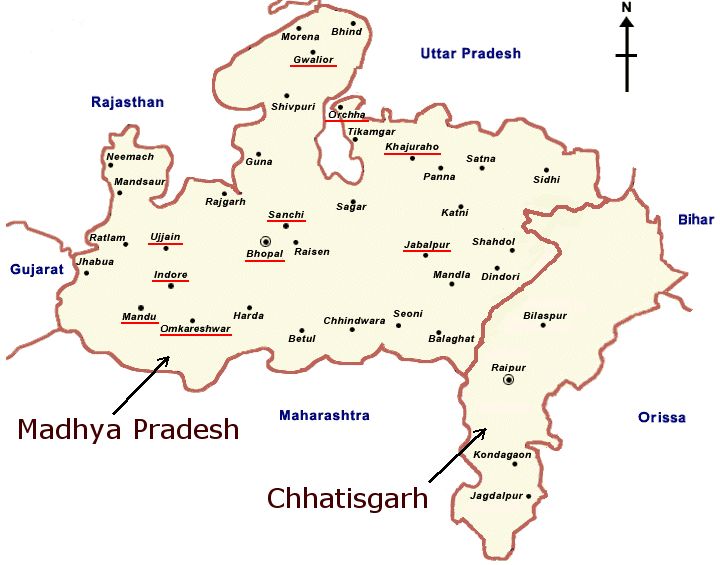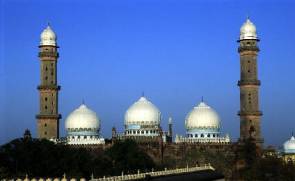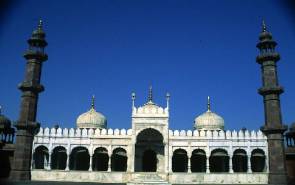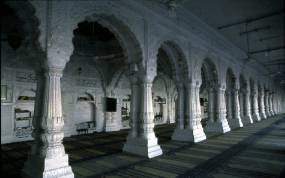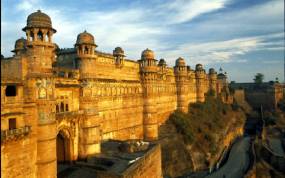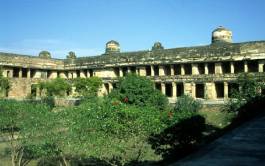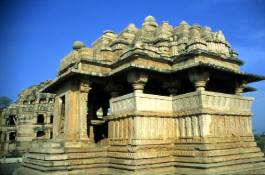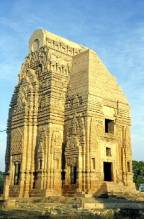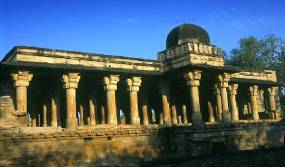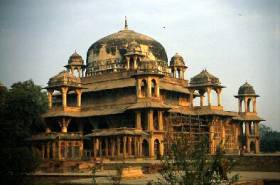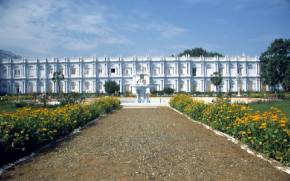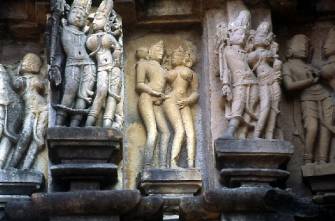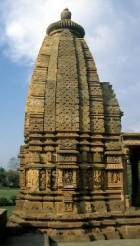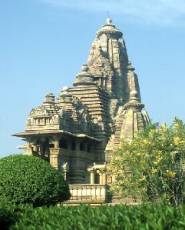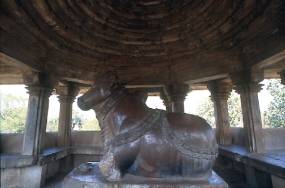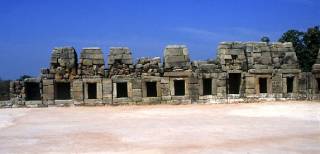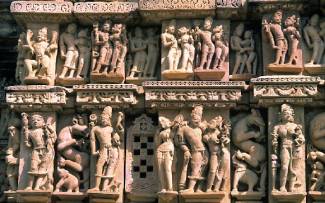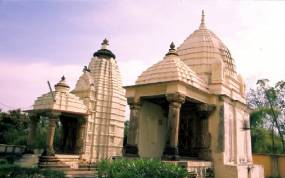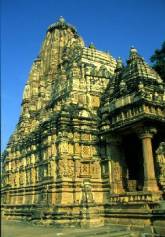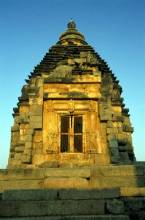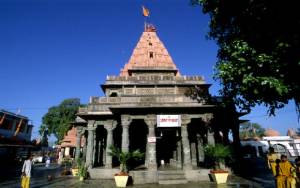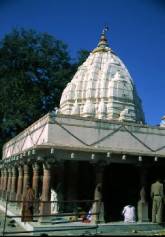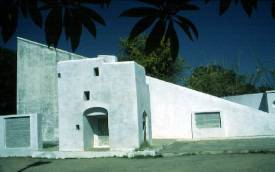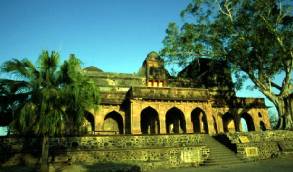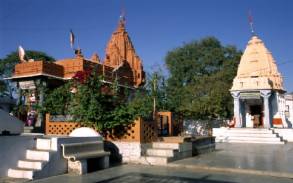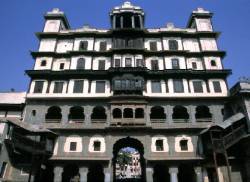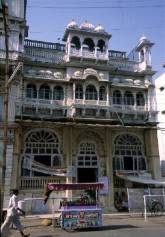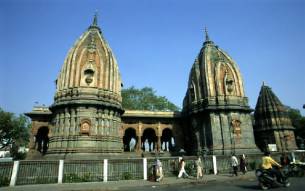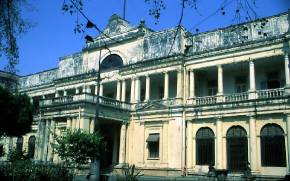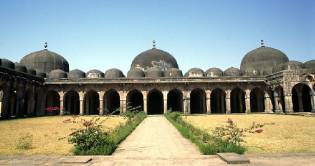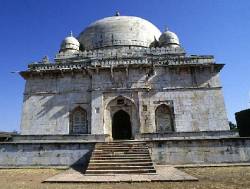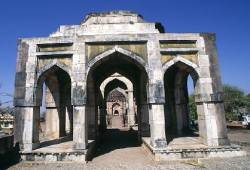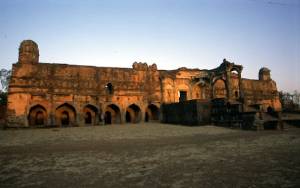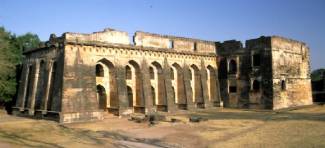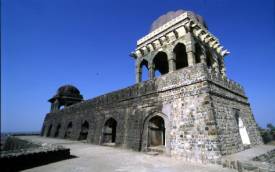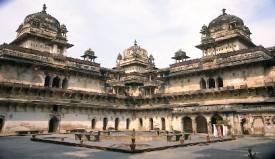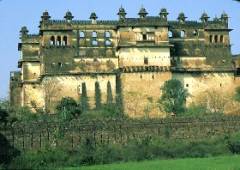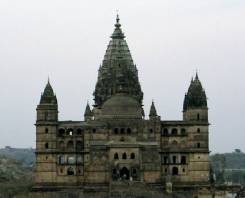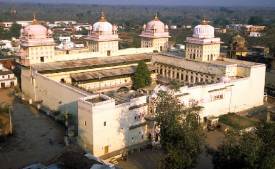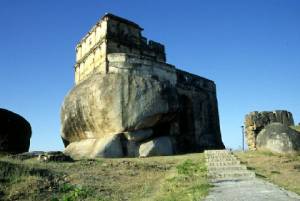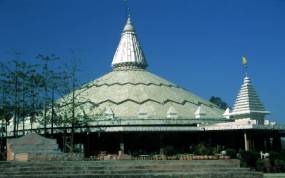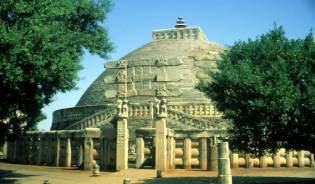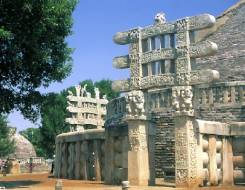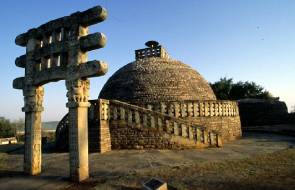The state of Madhya Pradesh occupies a large part of the center of the Indian peninsula. It is the largest state in India. It covers an area of 443,450 km2 for 67 million inhabitants. Its capital is Bhopal. The main language spoken is Hindi. 40% of the population is of tribal origin. The three great tribes are the Gond, the Bhils, and the Oraons.
Agriculture is the basis of the economy of Madhya Pradesh. The main crops are rice, wheat, maize, legumes. The Chhatisgarh is rich in minerals (iron, coal, manganese, bauxite, etc ...) and has large forest resources, but not all of these resources are exploited optimally. The state suffers from a lack of infrastructure development.
History
The history of this part of India really begins in the time of Ashoka, the great king Maurya, in the 3rd century BC. At the time the region was called Malwa. It was then integrated into the territory of the Gupta Empire until the seventh century when the region was divided into smaller kingdoms. Several dynasties had a certain influence, including the Parmara and the Chandela in the eleventh century. The Muslims then entered India and Madhya Pradesh was partly integrated in the Sultanate of Delhi then the Mughal empire. In the 17th century, the marathons disputed the region with the Mughals who had to withdraw. But the region again broke up into small states, thus opening the way to English colonization. At independence the Central Provinces and the Berar were united to form Madhya Pradesh. In November 2000 Madhya Pradesh was amputated from part of its territory to give birth to the state of Chhatisgarh because of the cultural peculiarity of this region. This creation went without major shock.
Map of the province of Madhya Pradesh and Chhatisgarh
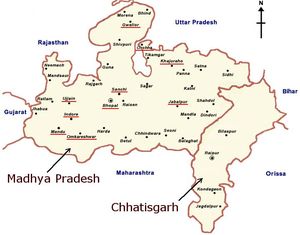
Map of Madhya Pradesh and Chhatisgarh
Bhopal
Bhopal is the capital of the state of Madhya Pradesh. It has a population of 1.3 million. The city was created in the eleventh century by Raja Bhoj. It first bore the name of Bhojpal and later became Bhopal. Raja Bhoj built the two artificial lakes in the city. But the city developed mainly during the reign of the Afghan Dost Mohammad Khan between 1708 and 1740. The city resisted then the attacks of the marathas at the end of the eighteenth century. Then, for more than a century, from 1818 to 1926, it was the begers who led Bhopal.
The architecture of the city is a mix of Muslim and Hindu styles. Bhopal is the cultural center of Madhya Pradesh but it is not very touristy. Bhopal's history was, of course, marked by the terrible industrial catastrophe that hit the city in 1984. On the evening of December 3, following the negligence of an employee of the Union Carbide factory, 40 tonnes of MIC (isocyanate methyl) spread in the city, killing several thousand people in a few hours (the official record has never been established, it would be between 5000 and 30000 victims). Several tens of thousands of people were severely intoxicated and an estimated 15 people are still dying a month from the direct consequences of the disaster. Pursued by the Indian state, Union Carbide arranged to pay $ 470 million in compensation in exchange for dropping the lawsuit. A very small portion of the money actually came into the hands of the families of the victims and the hospital built with this money is mainly used to fatten its leaders.
A monument was erected in memory of the victims in front of the now abandoned factory. Traveler, remember.
The Taj-Ul-Masjid
This impressive mosque is one of the largest mosques in India. Taj-Ul-Masjid means "Crown of the mosques". Its construction was initiated by the beag Shah Jahan during its reign (1868-1901) but it was several times interrupted for lack of means. Work resumed in 1971! The main pink building is surmounted by three large white domes and is flanked by two large minarets.
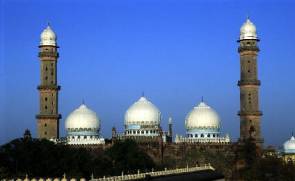
The Taj-Ul-Masjid
The Moti Masjid
This mosque was built by the beggar Sikandar Jehan in 1860. Like the great reformer Begum, the mosque has a modern appearance. Its façade, inspired by the Delhi Jama Masjid, is in white marble, flanked by two black minarets topped by golden arrows.
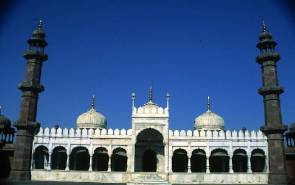
The Moti Masjid
The Jama Masjid
This mosque was built in 1837 by the Qudsia Begum. It is located in the center of the main bazaar of Bhopal. Smaller than the Taj-Ul-Masjid, it has two large minarets and three domes. Its main attraction is actually inside. One can indeed see there magnificent examples of Islamic architecture including a series of arches of white alabaster and a very beautiful pool of ablutions.
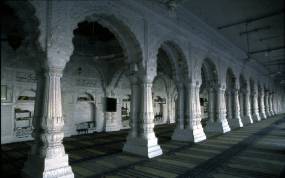
The Jama Masjid
The Bharat Bhavan
This building was inaugurated in 1982 to promote the arts. In addition to its collections of modern Indian paintings, Bharat Bhavan has a gallery devoted to adivasis art (tribal art). The place also offers dance, theater and music.
The museum Birla Mandir
This museum was built near the temple of Lakshmi Narayan. It houses very beautiful collections of statues with religious characteristics. They mainly represent Shiva, Vishnu and the goddesses. The section devoted to Vishnu shows its many avatars and that of Shiva shows it often depicted on bas-reliefs recounting his life on Mount Kailash.
The Gohar Mahal
This palace was built by the Qudsia Begum in 1820. It is a perfect example of the fusion between Islamic and Hindu architecture. Unfortunately today it is partly dilapidated but the vaulted corridors and arches have retained their grandeur.
Gwalior
Like many Indian cities, Gwalior's foundation is more legend than reality. The city would be born in the eighth century of the meeting between Suraj Sen, a local chief, and the hermit Gwalipa. The latter took care of Suraj Sen from leprosy. To thank him he founded a town by giving it the name of the hermit. Gwalipa predicted that the descendants of Suraj Sen would remain in power as long as he bears the name of Pal. This prediction was confirmed until the 83rd sovereign. The 84th was called Tej Karan and lost power.
The town changed hands several times between 1232 and 1751. In 1398 the Tomar dynasty took control of Gwalior. In 1505 Man Singh, the greatest of the Tomar, repulsed Sikandar Lodi from the Sultanate of Delhi. But in 1516 the successor of Sikandar, Ibrahim Lodi, made the siege of Gwalior who fell a year later. It was then the turn of the Mughals, under Babur, to take the city. They remained in control until the eighteenth century. In 1738 the Marathi Ranoji Scindia seized Gwalior. When the British colonized India, Gwalior came under their control, the Scindia while keeping the management. In 1857, during the revolt of the sepoys, the Indian troops of the fort followed the movement of mutiny while the maharaja remained faithful to the English. A bloody repression ensued.
Today still the maharaja of the city is a Scindia. Madhav Rao Scindia is also a member of Parliament.
The Gwalior area is known for its highway bandits, the dacoits. The most famous of the dacoits is Phoolan Devi, nicknamed "the queen of the bandits". Imprisoned for 11 years, she is now a member of Parliament.
The fort
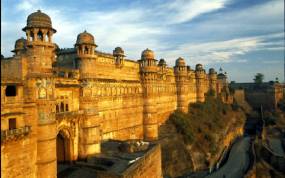
The fort
The fort of Gwalior has a history of more than 1000 years and was the stronghold of all those who reigned over the region. It was built on a hill 3 kilometers long. The ramparts are 10 m high and surround the top of the hill. The fort contains many monuments:
The Man Mandir Palace: this palace was built by Man Singh between 1486 and 1517. At the time the roofs were covered with copper and gold tiles that have now disappeared. Some walls are covered with ceramics and paintings showing ducks, elephants, peacocks, etc. It has four levels, two of which are underground. You have to walk through Man Mandir to discover the rich decorations, paintings, friezes, cupolas, balconies, etc.
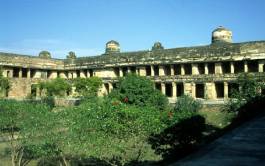
The Man Mandir Palace
The Sasbahu Mandirs: These are two temples. Sas and Bahu means mother and daughter-in-law in Hindi. Dedicated to Vishnu, they were built by Mahipala Kachhawaha in 1093. He built the largest for his mother and the smallest for his wife. They have a cross shape and respect the traditional architecture of the Hindu temples. One can see human figures carved on the walls. The central part of the great temple has four large pillars supporting the roof.
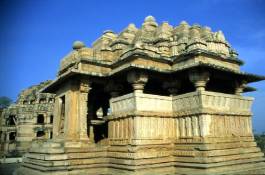
The Sasbahu Mandirs
The Teli-ka-Mandir: it is the oldest monument of the fort. Despite its unusual shape it is a temple entirely covered with sculptures. The entrance door is surmounted by an effigy of Garuda, the sacred mount of Vishnu .
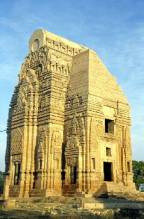
The Teli-ka-Mandir
The Bawadi: This is a reservoir that could store a large amount of water to supply the fort. It has 80 pillars and once housed a temple dedicated to Shiva. When the Mughals seized the fort, he threw the lingam of the temple down the cliff. It was found only hundreds of years later.
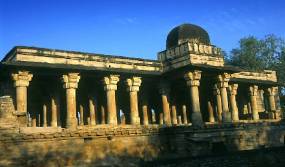
The Bawadi
The tomb of Mohammad Ghaus
It is the mausoleum of a Muslim saint who helped the Mughal Babur to seize the fort of Gwalior. It was built in the 16th century in the Mughal style, it has a square shape and is flanked by four domed towers. The large central dome was once covered with blue ceramic tiles.
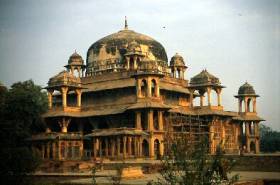
The tomb of Mohammad Ghaus
The tomb of Tansen
Tansen was the most famous musician in the court of the Mughal emperor Akbar. The legend tells that his melodious voice gave birth to the clouds. His tomb was built in the 17th century in a garden where a festival of music is held every year. The leaves of the tamarind tree found there would have magical properties including that of lightening the voice.
The palace Jai Vilas
This palace was built between 1872 and 1874 by Sir Michael Filose for the visit of the Prince of Wales. Although built of sandstone it was painted white to give the illusion of marble. The maharaja of Gwalior still resides in the palace but 35 rooms are reserved for the museum. In the Dunber Hall two enormous candlesticks of more than three tons each are suspended from the ceiling. Before hanging them, the architects had ten elephants mounted on the ceiling to test its solidity. The walls of the room were decorated with gold leaf (58 kg was necessary). There are many other sights to see, including erotic statues, crystal furniture, miniature vehicles and especially the little train that brought the digestive and cigars to the table after dinner.
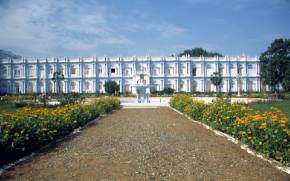
The palace Jai Vilas
Khajuraho
The small town of Khajuraho is known throughout the world for its temples. It is not clear why the Chandela chose this site for their edification between the tenth and eleventh centuries. Originally the village was called Khajirvahila and it was King Chandravarman, founder of the Chandela dynasty, who built the first temple. At the end, the complex consisted of 85 temples but only 22 resisted the onslaught of time.
The reputation of the site is due to the magnificent statues adorning the walls of the temples and detailing the Indian life of the time with its divinities, animals, artists and also poses of Kamasutra. Although each temple has a different shape, all have some common architectural features. They are all seated on a platform of several meters high (adisthana), they have an entrance hall (mandapa) and a sanctuary (garbhagriha) where the idol of the temple is located. The sanctuary is crowned with a conical tower (shikhara). It should be noted that architects never used mortar or cement.
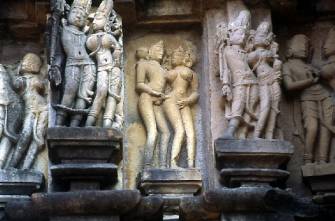
Temples of Khajuraho
The temples were grouped into three sectors: the West, East and South sectors.
The Temples of the Western Sector
They are all Hindu and are the finest examples of Chandela art.
The temple of Lakshmana : it is one of the oldest temples of Khajuraho, built between 930 and 950, and dedicated to Vishnu. Surrounded by four small sanctuaries, it is also one of the most beautiful. The platform is surrounded by friezes showing elephants and horses in procession, apsaras (celestial nymphs) and erotic poses. The circular ceiling of the porch is carved in the form of a lotus. There are erotic sculptures inside the temple.
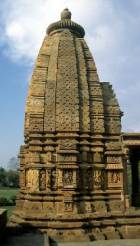
The Temples of the Western Sector: Lakshmana
The Kandariya Mahadev temple: built between 1025 and 1050, dedicated to Shiva, it is the largest temple of all and the most successful. The stairs of the temple lead to a platform decorated with sculptures of women in various poses. On the north and south sides are some of the most sensual erotic statues of Khajuraho. Smaller friezes show life at court, processions of elephants and horses. The holy of saints contains a marble lingam and its shikhara culminates at 31 meters.
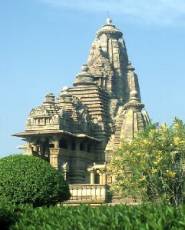
The Temples of the Western Sector: Kandariya Mahadev
The Vishwanatha temple: It takes up the plans of the Kandariya Mahadev. On the platform is a statue of Nandi (sacred mount of Shiva) sheltered under a pyramidal roof. On the friezes are beautiful statues of women going about various occupations. The holy of saints contains a marble lingam.
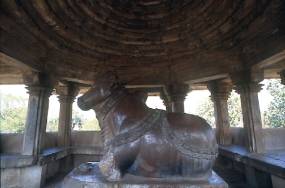
The Temples of the Western Sector: Vishwanatha
The Vahara temple : it is dedicated to the third incarnation of Vishnu, Vahara the boar. The sanctuary houses a large statue in Vahara sandstone dating back to the year 900.
The Mahadeva temple : it is on the same platform as the Kandariya Mahadev. Although in very poor condition one can see there a superb sculpture representing a sardula (mythical monster) caressing a lion.
The Chitragupta temple : built at the beginning of the 11th century it is the only temple dedicated to Surya the god of the sun. The Saint of the saints houses a sculpture of Surya leading his chariot pulled by seven horses and a statue of Vishnu with 11 heads showing his 10 incarnations. The temple is unfortunately in rather bad condition.
The Mantagesvara temple : probably one of the oldest on the site. Outside is a statue of Ganesh on which the faithful pose garlands of flowers. A large, 2.5m high polished lingam is located inside.
The Chausath Yogini : it is a little removed from the other temples. It was built in granite around the year 900. Chausath means 64 because the temple contained 64 cells housing the statues of the Yogini who attended the goddess Kali.
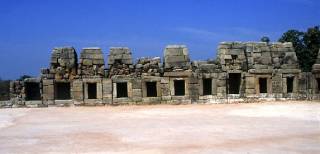
The Temples of the Western Sector: Chausath
The Temples of the Eastern Sector
The Parshvanatha temple: it is the largest of the Jain temples on the site. The beauty and finesse of his sculptures are exceptional, the most famous being that of a woman removing a thorn from her foot and that of a woman removing makeup. The temple was originally dedicated to Adinath but today it is a statue of Parshvanatha, one of the Tirthankara, which adorns the sanctuary.
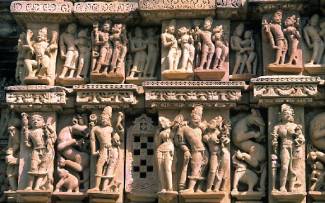
The Temples of the Eastern Sector: Parshvanatha
The temple of Adinath : it is a Jain temple, smaller than that of Parshvanatha. Like the Hindu temples it is surrounded by three carved friezes. A black statue is located within the sanctuary.
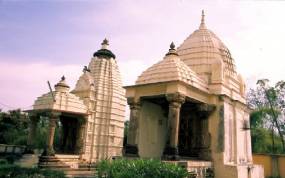
The Temples of the Eastern Sector: Adinath
The Shanti Nath temple is the most recently built temple, about a century ago, but contains elements recovered from older temples. The 4.5-meter high Adinath statue would date from 1028. Groups of Jain pilgrims are sometimes found in the temple.
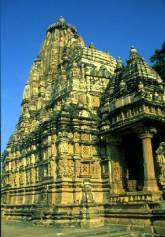
The Temples of the Eastern Sector: Shanti Nath
The Brahma and Hanuman temple : The Brahma temple (photo) was built of sandstone and granite but contrary to what its name leaves hear it is dedicated to Vishnu . The Temple of Hanuman contains a statue of the monkey god 2.5 meters high on which the date of 922 can be read.
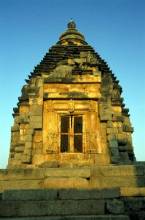
The Temples of the Eastern Sector: Brahma et Hanuman
The The temple of Ghantai : this is a ruined Jain temple. Only the columns carved with their decorations in the form of chains and bells remain. A statue of a goddess Jaina riding the eagle Garuda is at the entrance.
The Javari temple : Dating from 1075-1100, this temple is dedicated to Vishnu. Although smaller than the other temples of the same style, it features beautiful female statues.
The Vamana Temple : This temple is dedicated to Vamana, the dwarf incarnation of Vishnu. The exterior sculptures are remarkable, especially those of the "celestial nymphs."
Les temples du secteur Sud
Le temple de Duladeo : Datant du XIIe siècle il est l'un des derniers temples construits. Le travail des artistes s'en ressent car les statues sont un peu moins originales que celles du groupe ouest.

The Temples of the Eastern Sector: Duladeo
Le temple de Chaturbhuja : Ce temple est en ruine mais possède encore une statue de Vishnu haute de près de 3 mètres.
Ujjain
Ujjain is one of the seven sacred cities of Hinduism, and it is also one of the seven cities where the Kumbh Mela takes place (see the city of Nasik for explanation of this feast.) The city is mentioned in the Vedas the sacred texts of the Hindus).
The origins of the city are very ancient. Ujjain, called Avantika at the time, began to make its name during the reign of Ashoka in the 3rd century BC The Gupta who reigned over the Malwa region between 320 and 540 made Ujjain an important center of their kingdom. After the Gupta, the Rajputs controlled the Malwa plateau politically, then the Parama and the sultans of Mandu. Ujjain was plundered several times by the neighboring provinces (Chalukya, Chandela ...).
In the twelfth century, the Malwa was completely invaded by the Muslims. The city was several times captured by the successive Muslim dynasties. In 1562 the Mughal Akbar took Ujjain from the Afghans. Akbar and Aurangzeb contributed financially to the restoration of the ancient temples of Ujjain. In the 17th century the Marathes and then the Scindia took control of the city and built many temples. In 1810 the Scindia moved their capital from Ujjain to Gwalior. From then on the commercial and political importance of the city declined.
The temple of Mahakaleshwar
This temple, mentioned by the great poet Kalidasa in his writings, is devoted to Shiva. It is very important for the Hindus as it is home to one of the twelve jyothirlinga (natural lingam) of India. It is through the lingam that Shiva manifests his power. The idol of the temple is called Dakshinamurti because it faces south (dakshin).
The temple was destroyed during the 13th century Muslim invasions and rebuilt by the Scindia. The floors of the temple feature balconies with richly decorated roofs and the corridors leading to the sanctuary have marble columns. You can also see statues and ancient sculptures.
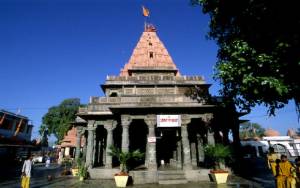
The temple of Mahakaleshwar
The Chintaman Ganesha Mandir
This temple dates from the eleventh century, at the time of the Parama. The Hindus believe that the idol of Ganesh inside the temple is a swayamabhu, that is, born by itself. The temple has an assembly hall surrounded by carved pillars.
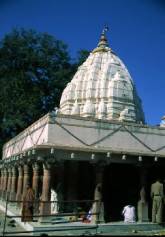
The Chintaman Ganesha Mandir
The Vedha Shala
This observatory is one of the astronomical sites built by maharaja Jai Singh. The Vedha hala was erected in 1725 and is much smaller than the observatories of Delhi and Jaipur. It was not built there by chance since the reference meridian of the Hindu geographers passes through Ujjain. The observatory consists of four elements: the Samantha Yantra (a sundial), Nadi Walaya Yantra, Dignasha Yantra and Bhitti Yantra.
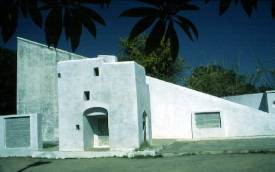
The Vedha Shala
The palace Kaliadeh
This palace was built in 1458 by the sultans of Mandu in place of an ancient Hindu temple dedicated to the sun on an island 8km north of the city. The central hall is surrounded by galleries. The waters of the river are brought into a reservoir from which they pour into a sculptured partition. The palace was restored in 1920 by Maharaja Madhav Rao Scindia.
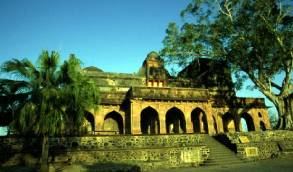
The palace Kaliadeh
The temple Hara Siddhi
This temple was born from a legend. Shiva, who had just lost his wife Sita, promised not to part with her body any more. The other gods, puzzled by this attitude, decided to cut the body of Sita and throw the pieces on the land of mortals. Thus the places where these pieces fell became satktipeeth, that is to say, places where the feminine energy manifests itself.
The Hara Siddhi temple rises to the spot where Sita's shoulder has fallen. In the center of the sanctuary is a rock that represents the head of King Chandragupta Vikramaditya (380-415) offered to the goddess Durga. It houses a dark red representation of the goddess Annapurna, two large feet of iron lamp 5 meters high and the Sri Yantra (nine triangles representing the nine names of Durga.)
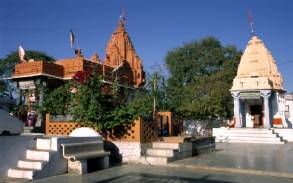
The temple Hara Siddhi
The temple Gopal
This temple dedicated to Krishna was built in the 19th century by Bayajibai Scindia, the wife of the Maharaja of the time. The marble spire that overhangs the temple is characteristic of the Marathi style. A statue of Krishna in silver is in the sanctuary. The silver-clad doors of the latter were originally in the temple of Somnath from which they were removed by Mahmud Ghazni in 1026. They then went to Lahore where Mahadji Scindia found them before they were installed in this temple temple.
The temple Navagraha
This temple is dedicated to the nine planets (navagrahas) of the solar system. He recalls that Hindu astrology is very important in the life of the faithful. The idol of Saturn is one of the most venerated because fear by the faithful.
Indore
The history of Indore is relatively recent and presents little interest. The area of Indore was offered by the rulers of Pune to Malhar Rao Holkar in 1733. It was under the rule of his daughter-in-law, Ahilya Bai Holkar, that the city developed. The Holkars resisted the marathons and sovereigns of Gwalior but not the English to whom they had to pledge allegiance in 1818. The Holkar dynasty retained its royal titles but was controlled by a British resident. In 1947 Indore joined the Indian republic as the majority of the small princely states. The Holkars, however, are still considered the kings of Indore.
Murshidabad is watered by an important arm of the Ganges, the Bhagirathi. The city is known for its silk.
The Juna Majwada
It is the palace of the rulers of Indore, at least what remains of it, for it was thrice ravaged by fires. The last one, in 1984, left intact only the facade with six floors. The palace was built by Malhar Rao Holkar II (1811-1834).
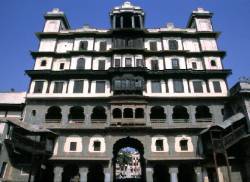
The Juna Majwada
The Kanch Mahal
It is a temple of Jaina (temple of Seth Hukanchand). Thousands of mirrors adorn the walls, floor and ceilings. Glass lanterns and chandeliers decorate the interior. There are more than 50 scenes depicting sinners tortured in the afterlife, scenes of conversion to Jainism and scenes from the life of the court in the 19th century. The statue of Mahavira is made of black onyx.
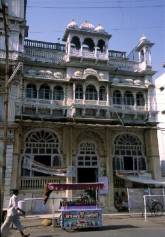
The Kanch Mahal
The Chhattri Bagh
This garden houses the cenotaphs (chhattri) of the rulers of Indore. The largest is that of the founder of the dynasty, Malhar Rao Holkar. It is decorated with sculptures and bas-reliefs. The most revered chhattri is that of the only sovereign of the dynasty, Ahilya Bai Holkar. Most of the cenotaphs are poorly maintained and the inner sanctuaries are locked.
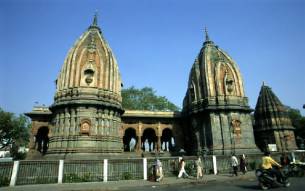
The Chhattri Bagh
The palace Lal Bagh
It was built between 1886 and 1921 by Shivaji Rao Holkar. The entrance portal is a replica of that of Buckingham Palace in London. The palace has a ballroom whose floor is mounted on springs. Some rooms have been restored and converted into a museum. There is a collection of coins from the Muslim period, paintings, miniatures and sculptures.
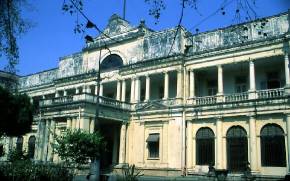
The palace Lal Bagh
The temple of Bada Ganapati
This temple houses a large statue of Ganesh. It has the peculiarity of being orange and measuring 8 meters high. It would be the tallest statue of Ganesh in India.
Mandu
It is known that the hill of Mandu was fortified from the sixth century but it was only in the 10th century with the arrival of Paramara and the establishment of an independent state by Raja Bhoja that Mandu began its development. The fortress was conquered at the beginning of the fourteenth century by the sultanate of Delhi. In 1401 the Mughals seized Delhi and it was the governor of the Malwa, the Afghan Dilawar Khan, who took control of Mandu to make it the capital of an independent kingdom. The first kings of the dynasty were great builders. In 1526 Bahadur Shah of Gujarat seized Mandu and was himself defeated by the Mughal Humayun in 1534. One of the princes of the ancient dynasty, Baz Bahadur, took power over Mandu but fled before the advance of Mughal troops sent by Akbar in 1561.
Definitely annexed to the Mughal empire, Mandu nevertheless retained a certain autonomy. She fell again in front of the marathons. The capital of the Malwa was then moved to Dhar. The influence of Mandu then quickly faded and quickly became a ghost town.
The Jahaz Mahal
Nicknamed "the palace of the boat", this building was built in the 15th century between two lakes, Munj Talao and Kapur Talao. Ghiyath-ud-Din decided to build it to house his harem. 120 meters long, the palace has a terrace with kiosks and pavilions. Inside is a large basin.

The Jahaz Mahal
The Jama Masjid
The construction of this mosque began under Hoshang Shah and ended in Mahmud I in the 15th century. It was modeled on the great mosque of Damascus. The courtyard is surrounded by colonnades and the building is surmounted by several domes. The wall of the qibla (oriented towards Mecca) is decorated with 17 crenellated niches.
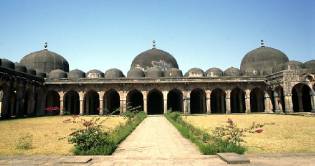
The Jama Masjid
The tomb of Hoshang Shah
It is the mausoleum of Hoshang who died in 1435. Constructed of marble, it has a well proportioned dome. Openwork marble latticework illuminates the interior. The base, in the form of a square, is transformed into an octagon as it rises. On the upper level the sides of the octagon are still divided in two. The architects of the Taj Mahal went to Mandu before beginning their work in Agra.
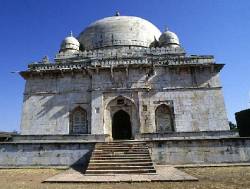
The tomb of Hoshang Shah
The Ashrafi Mahal
This building was originally built by Mahmud Shah Khalji to be a religious school (madrassa). But he changed his mind and finally made it his mausoleum. For this he had the building enlarged but a lack of construction made it crumble.
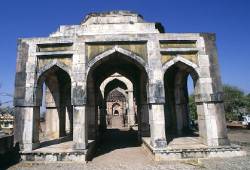
The Ashrafi Mahal
The mosque of Malik Mughis
It has a courtyard with colonnades and a number of Hindu architectural motifs. The western colonnade is adorned with three domes and the wall is decorated with blue tiles.
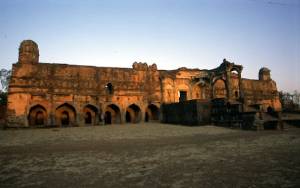
The mosque of Malik Mughis
The Hindola Mahal
Nicknamed "the oscillating palace" due to the inclination of its walls, it was built in 1425 under the reign of Ghiyath-ud-Din to serve as pavilions of the audiences.
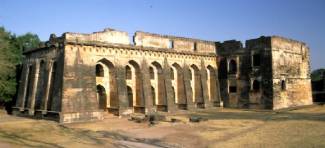
The Hindola Mahal
The palace of Baz Bahadur
It was built in 1509, well before Baz Bahadur came to power. The main part of the palace is a large open courtyard with halls and rooms on the sides. On the north side is an octagonal-shaped pavilion with arches. The palace was supplied with water by a well, the nearby Rewa Kund.
The pavilion of Rupmati
It is believed that it was originally built to serve as an observation post in the early 15th century. It was later enlarged and served as a residence for Rupmati, the mistress of Baz Bahadur. From there she could observe the Narmada flowing in the plain. Legend has it that Rupmati poisoned himself when the Mughal Akbar seized Mandu.
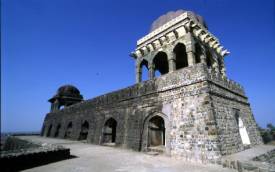
The pavilion of Rupmati
The Taveli Mahal
This former palace offers a beautiful view of Mandu and the region. It also houses an archaeological museum.
Orchha
The history of Orchha is related to that of the Bundela dynasty founded in the eleventh century. The city became their capital in 1531 and remained until 1783. The Bundela had conflicting relations with the Mughals. In 1602 Bir Singh Deo, the ruler of Orchha, drew the wrath of the Mughal Emperor Akbar because he had allied himself with Jahangir, the latter's rebellious son. The kingdom Bundela was saved by the death of Akbar and the accession to the throne of Jahangir. The Bundela attempted to revolt against the following Mughal emperors but without success. In 1783 they moved their capital to Tikamgarh.
The temple of Lakshmi Narayan
Vir Singh Deo built this temple in honor of the goddess Lakshmi in 1622. It was restored in 1793. Inside the walls are covered with well preserved frescoes . The temple has an altar shaped like a vulva (yoni) but there is no effigy of the goddess. However, there are those of Radha and Krishna.

The Jahaz Mahal
The Jahangir Mahal
Built at the beginning of the 17th century, this palace bears the name of the Mughal Emperor who is the friend of the sovereign Bundela, Vir Singh. The building has five levels and eight pavilions. The sovereigns received their subjects on the second floor, in a courtyard. The facade of the palace is decorated with geometric motifs and paintings.
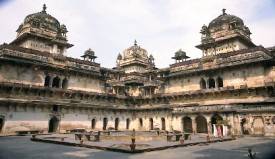
The Jahaz Mahal
The Raja Mahal
The construction of the palace began in the reign of Raja Rudra Pratap but was interrupted by his death in 1531. His son finished the facade and the main part. The final touch was carried by Madhukar Shah. The palace is organized around two courtyards and contains magnificent paintings. Two rooms are worth a visit: the Durbar Hall and the Diwan-i-Am. This last being the room where the sovereign held his councils of ministers. It has large columns and a ceiling decorated with paintings.
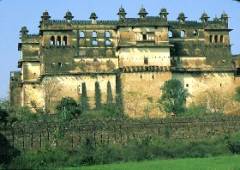
The Raja Mahal
The temple of Chaturbhuj
This Hindu temple was built between 1558 and 1573 by Raja Madhukar. Due to its architecture, privileging space and light, it looks more like a cathedral than a temple. It is dedicated to Chaturbhuj, a four-armed form of Vishnu.
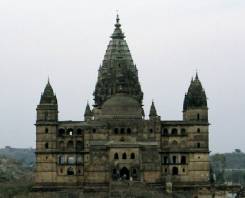
The temple of Chaturbhuj
The chhatris
They are royal cenotaphs of the sovereigns of Orchha. There are 14 and with the exception of Raja Vir Singh Deo, they have a temple shape. They were erected on the banks of the Betwa.

The chhatris
The temple of Rama Raja
It was built by Raja Rudra Pratap and his son Raja Bharti Chandra. It was first a palace for royal women. One of them, the Maharaani Ganesh Kunwar, installed a statue of Rama and the place became known as Rama Raja. The temple has square courtyards surrounded by apartments of Hindu-Islamic architecture.
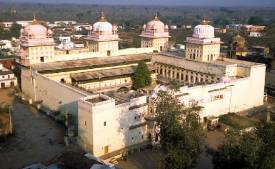
The temple of Rama Raja
Jabalpur
The origin of the city is very ancient since it is mentioned in the Mahabharata and in the Puranas. During the reign of the Maurya, Jabalpur and the surrounding areas became more important. The control of the region then passed into the hands of the Satavahana, the Bodhin, the Gupta and the Kalchuri in the eighth century. The latter reigned until the twelfth century. They were prolific builders and participated in the fame of Jabalpur.
The region was then taken by the Gond. It took the name Gondwana. Several times assailed by the Mughals it nevertheless succeeded in maintaining its independence until the arrival of the marathes in the eighteenth century. Their arrival was accompanied by that of the Thugs who flew and killed in the name of the goddess Kali. It was not until the arrival of the British in 1817 that they were persecuted. The English developed the economy of the region and left many colonial buildings.
The Madan Mahal
Located on the top of an enormous rock, this fortified palace was built by Madan Shah in the 12th century. It is probably the only strong of this type, seeming to have been carved in the rock itself. A vaulted door leads to the fort. Most of the walls that surrounded the rock collapsed and it seems that this building never served as a defense position.
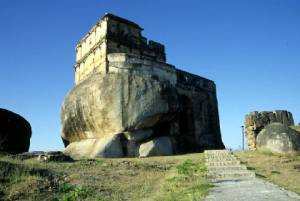
The Madan Mahal
The temple Pisan Hari
It is a Jain temple. It was built by a woman thanks to the savings she had accumulated. It has a circular structure surmounted by a dome crowned with an arrow. A large hexagonal column with an alcove is located near the temple. The view on Jabalpur from the place is impregnable.
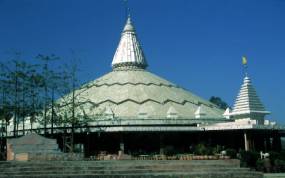
The temple Pisan Hari
The Durgavati museum
This museum was opened in 1964 and named after the queen who fought the Mughals. It houses beautiful collections of medieval stone sculptures and prehistoric objects. A beautiful carved 10th century red sandstone fresco shows Shiva and Parvati playing on the slopes of Mount Kailash under the eyes of other Hindu divinities.
A room is reserved for the history of Jabalpur during the reign of the Gond. An evocation of the life of the mahatma Gandhi is also presented with photos and letters.
Sanchi
Sanchi is one of the most important centers of Buddhist worship in India. Sanchi was always celebrated for his calm and tranquility. This was probably what led King Ashoka to build the first stupas in the 3rd century BC But Buddhism was quickly on the decline and the site of Sanchi was gradually forgotten. It was not until 1818 that a British officer, General Taylor, discovered it. The archaeological excavations were then very badly carried out and caused a lot of damage. In 1881 a more rational restoration was undertaken and many of the buildings were rebuilt between 1912 and 1919 by Sir John Marshall.
The big stupa
A stupa is a Buddhist monument in the shape of a dome supposedly sheltered from the holy relics. The Great Stupa of Sanchi was erected by Ashoka and subsequently enlarged. Today it measures 16 meters high for 37 meters in diameter. It is surrounded by a kind of stone fence with four gates (the toranas) added towards the year -35. They are oriented towards the 4 cardinal points.
The North torana: The two pillars are 8.5 meters high and are decorated with scenes from Buddhist tales and scenes from Buddha life. It is noted that at the time, Buddha was never represented in human form but by a series of symbols (lotus, banyan, wheel ...) A scene shows a monkey offering a bowl of honey. Elephants support the horizontal beams above the torana.
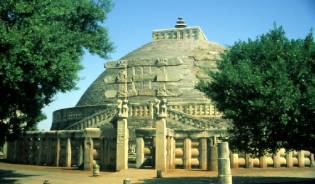
The big stupa
The west torana: The horizontal beams of this portal are supported by dwarfs. This portal shows seven incarnations of Buddha. A scene recounting one of these incarnations in monkey form is found at the top of the right pillar. Another, showing an incarnation in the form of a six-elephant elephant, is on the bottom beam. One can also see Buddha resist the temptation of Mara and applauded by angels.
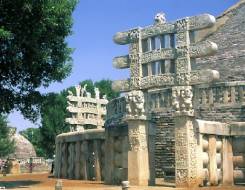
The big stupa
The Southern torana: This is the oldest portal. It shows scenes relating the birth of Buddha and the life of Ashoka after his conversion to Buddhism. Behind one of the horizontal beams one can see a scene evoking the departure of Prince Siddharta (future Buddha) of Lumbini, the capital of his father.
The East torana: It depicts several scenes from the life of Buddha when he was in search of enlightenment. On one of the pillars a scene shows Queen Maya, the mother of Buddha, dreaming of an elephant on the moon on the day of her son's conception. The statue of a yakshi (kind of elf) hanging from one of the horizontal beams, is one of the most well known of the site.
The stupas
There are other stupas built on the hill. The most interesting are stupas number 2 and 3. Stupa number 2 does not have portals like the Grand Stupa but the enclosure wall is adorned with emblems whose motifs rival originality and fantasy: flowers, animals, characters, mythology, etc.
The stupa 3 was built around the 2nd century BC It has only a portal whose sculptures are more naive than those of the Great Stupa. Formerly it contained the relics of two disciples of Buddha, Sariputra and Maudgalyayana. They were taken to England in 1853 and taken back to Sanchi in 1953.
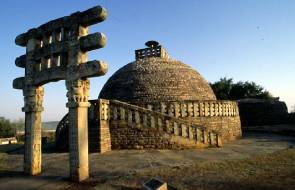
The stupas
The temples
The temple 17: It belongs to the Gupta period (5th century) and is considered one of the first representatives of Hindu temples built of stone: a flat roof, a single room, a small porch adorned with pillars leading to the sanctuary.
The temple 18: It dates from the 7th century. It has an apse with circular walls and a nave with columns flanked by wings.
The temple 31: Built in the 6th century and rebuilt in the 10th century, this temple houses a Buddha statue. The archaeologists believe that it was not intended to be installed in this temple because it does not fit exactly to its pedestal.
The monasteries
Buddhist monasteries were numerous but many disappeared because they were originally built of wood.
The monasteries 45 and 47 They were built at the end of the period of influence of Buddhism, they include some Hindu elements. Images of goddesses, intertwined couples, animals and lotus adorn the entrance. In the sanctuary is a seated Buddha.
The monastery 51: This is the most impressive. It was carved from the rock, like a large bowl used to collect food and offerings.
Omkareshwar
The city, or rather the village, is sacred to the Hindus as it is home to one of the twelve jyothirlingams of India (it is a lingam, symbol of Shiva, natural). The city derives its name from the word "om", the sacred syllable of Hinduism by which Shiva created the Universe. A part of the village extends on an island that seems to emerge from the Narmada.
The temple of Sri Omkareshwar Mahadeo
Also called Sri Omkar Mandhata temple, it houses the jyothirlingam. It was built with a particularly tender stone which allowed the artists to sculpt friezes superbly detailed.
The temple of Siddnath
A fine example of Brahmanic architecture. You can see a beautiful elephant frieze 1.5 meters high. Carved effigies decorate the upper part and the roof of the temple.
See also:





